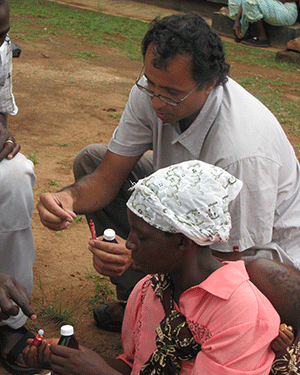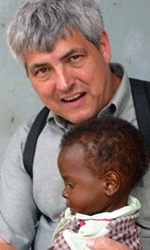
Severely malnourished children are far more likely to recover and survive when given antibiotics along with a therapeutic peanut-butter-based food than children who are simply treated with the therapeutic food alone, researchers at Washington University School of Medicine in St. Louis have found.
“The findings are remarkable,” says Indi Trehan, MD, lead author of the research, published Jan. 31 in The New England Journal of Medicine. “Based on previous research, we didn’t think there would be much benefit from antibiotics. We did not at all expect to see a drop in the death rate – but there was, and it is significant.”
The study involved nearly 2,800 children in Malawi, in sub-Saharan Africa, with severe malnutrition. Each child was given an average of 30 days of therapeutic food and a placebo or an oral antibiotic — either amoxicillin or cefdinir — for seven days.
Overall, 88.3 percent of the children enrolled in the study recovered from severe malnutrition. Deaths accounted for the largest proportion of children who did not recover, with the mortality rate considerably higher among those who received placebo than among those given antibiotics.
The researchers found a 44 percent drop in mortality with the use of cefdinir and a 36 percent drop with amoxicillin, compared with the use of no antibiotics.
Early last year, Trehan and Mark Manary, MD, senior author of the study, presented their findings to the World Health Organization, which establishes international guidelines for the treatment of malnutrition and other diseases.

“The addition of antibiotics has a profound impact that we hope will change how these children are treated worldwide,” says Manary, the university’s Helene B. Roberson Professor of Pediatrics. “This trial provided very solid, very objective, top-of-the-line scientific evidence to answer the question of whether antibiotics should be added to severely malnourished children’s treatment regimen. The answer is yes. This is a game-changer. This will save more lives.”
Adds Trehan: “Because of the large number of children who get this disease, the addition of antibiotics could impact potentially hundreds of thousands of children a year.”
More than a decade ago, Manary became a key player in introducing a simple but revolutionary peanut butter-based therapeutic food to battle severe malnutrition, an affliction that contributes to the death of 1 million children each year. This ready-to-use therapeutic food (RUTF) proved to be a lifesaver, with recovery rates at 85 to 90 percent. Consequently, RUTF is now used to treat malnourished children throughout the world. In Malawi, the epicenter of Manary’s and Trehan’s research and intervention, Manary’s “Project Peanut Butter” serves hundreds of thousands of malnourished children.
Still, despite markedly better outcomes for children treated with RUTF, 10 percent to 15 percent of children do not recover and many of them die, the new study notes. Those children were the impetus that led to the study involving adding antibiotics to the treatment regimen.
“You might think that something as simple as getting sick from not having enough to eat would be easily fixed by restoring a normal diet, but it’s not,” Manary says. “Starvation renders the body very vulnerable and susceptible to many infections. Just providing food so that children have enough nutrients to recover only goes so far.”
The study took place at 18 clinics in rural Malawi from December 2009 through January 2011. It involved 2,767 children ages six months to five years with uncomplicated severe acute malnutrition, meaning they were diagnosed as severely malnourished but still had good appetites, were not hospitalized and did not show signs of severe infection.
The children were randomly prescribed amoxicillin, cefdinir or a placebo, in addition to the fortified peanut butter food. Neither the researchers nor the caregivers knew whether a child was receiving an antibiotic or a placebo. The death rate was highest — 7.4 percent — among children who received a placebo, compared with 4.8 percent for those treated with amoxicillin and 4.1 percent for cefdinir, the researchers found. They noted no serious side effects from the antibiotics.
Trehan and Manary, both Washington University physicians at St. Louis Children’s Hospital, say the findings already have changed how they treat children at the field clinics they operate in Malawi. They stress that adding antibiotics to the treatment of severely malnourished children would involve using easily accessible, inexpensive, low-risk medications that can be administered by a child’s own family.
“It doesn’t involve complicated medical procedures to go after the biggest killer of children in the world — something that kills more kids than malaria, AIDS and tuberculosis — to reduce that death rate among those kids,” Manary says. “That’s what is so important about this. The practical implications are huge.”
An internationally regarded expert in malnutrition, Manary is also director of the Global Harvest Alliance, a joint venture between Children’s Hospital, Washington University and the Donald Danforth Plant Science Center that is, among other goals, working to eradicate childhood malnutrition.
Trehan, a clinical fellow in the university’s Department of Pediatrics, spent the last three years in Malawi conducting malnutrition research and served for more than a year on the faculty of the University of Malawi and as a consultant physician, teaching medical students and pediatric registrars at Queen Elizabeth Central Hospital.
Trehan I, Goldbach HS, LaGrone LN, Meuli GJ, Wang RJ, Maleta KM, Manary MJ. Antibiotics as Part of Management of Severe Acute Malnutrition. The New England Journal of Medicine. Jan. 31, 2013.
The research is supported by a grant from the Hickey Family Foundation, a cooperative agreement (GHN-A-00-08-0001-00) with the Academy for Educational Development Food and Nutrition Technical Assistance 2 project (through the Office of Health, Infectious Diseases and Nutrition, Bureau of Global Health, and Food for Peace, United States Agency for International Development), and grants (T32-HD049338) to Trehan and (UL1-RR024992) for statistical consulting, from the National Institutes of Health (NIH).
Washington University School of Medicine’s 2,100 employed and volunteer faculty physicians also are the medical staff of Barnes-Jewish and St. Louis Children’s hospitals. The School of Medicine is one of the leading medical research, teaching and patient care institutions in the nation, currently ranked sixth in the nation by U.S. News & World Report. Through its affiliations with Barnes-Jewish and St. Louis Children’s hospitals, the School of Medicine is linked to BJC HealthCare.